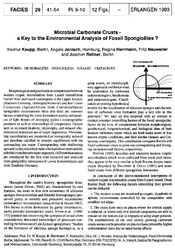Microbial carbonate crusts - a key to the environmental analysis of fossil spongiolites?
Zeitschrift: Facies, 199329: 41 - 54
DOI: https://doi.org/10.1007/BF02536916
Persistent URL: http://resolver.sub.uni-goettingen.de/purl?gldocs-11858/6841
Persistent URL: http://resolver.sub.uni-goettingen.de/purl?gldocs-11858/6841
Keupp, Helmut; Jenisch, Angela; Herrmann, Regina; Neuweiler, Fritz; Reitner, Joachim, 1993: Microbial carbonate crusts - a key to the environmental analysis of fossil spongiolites?. In: Keupp, Helmut; Jenisch, Angela; Herrmann, Regina; Neuweiler, Fritz; Reitner, Joachim (1993): Microbial carbonate crusts - a key to the environmental analysis of fossil spongiolites? - Facies; Vol. 29, p. 41-54, DOI: 10.1007/BF02536916.
 |
Dokument öffnen: |
Morphological and geochemical comparisons between
modern cryptic microbialites from Lizard Island/Great
Barrier Reef and fossil counterparts in the Upper Jurassic
(Southern Germany, Dobrogea/Romania) and late Lower
Cretaceous (Aptian/ Albian from Cantabria/Spain)
spongiolitic environments show that there are common
factors controlling the crust formations mostly independent
of light despite of diverging (paleo-) oceanographic
positions as well as relationships of competitors. Factors
such as increased alkalinity ,oligotrophy, and reduced allochthonous
deposition are of major importance. Thrombolitic
microbialites are interpreted as biologically induced
and therefore calcified in isotopic equilibrium with the
surrounding sea water. Corresponding with shallowing
upward cycles, microbial mats which produce stromatolitic
peloidal crusts become more important. Different biomarkers
are introduced for the first time extracted and analyzed
from spongiolitic limes tones ofLower Kimmeridgian age
from Southern Germany.

